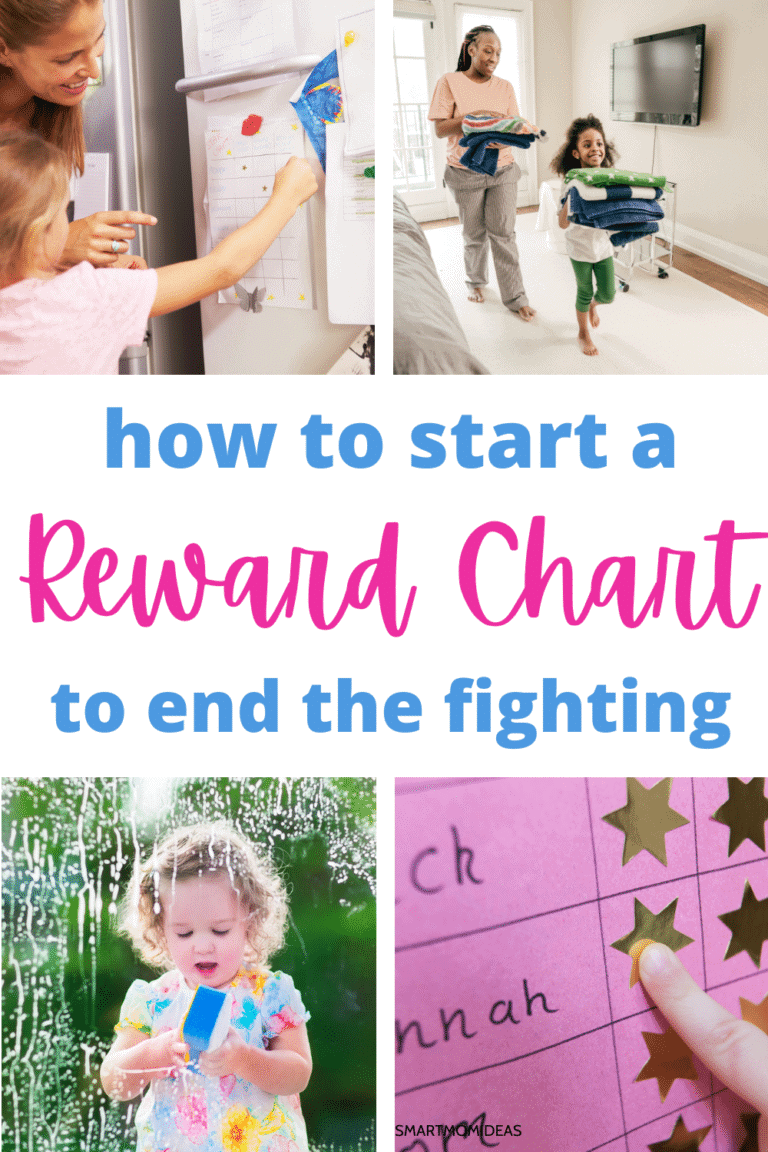Got a defiant toddler? A child that doesn’t listen? Try a reward chart.

“Hey sweetie, will you please wash the table?”
“Ugh. I don’t want to.”
“I don’t either, and I have all these dishes to wash too. We all need to pitch in.”
“Do I have to?”
This was a typical conversation my six-year-old boy and I would have nearly every day.
It was frustrating for him because he didn’t understand why I was interrupting his play time and asking him to do something boring.
And it was frustrating to me because I just wanted him to listen to me instead of arguing with me why or why not he has to do something. And what about my daughter? For some reason, she gladly stopped whatever she was doing and was happy to help around the home. #blessings
There are a lot of things that we want our kids to know and do, but they aren’t going to do it without first being shown how to do it and what the expectations are.
From potty training when they are two, to unloading the dishwasher every morning when they are ten and ensuring they are respectful to adults.
They need time to learn and practice and understand why they are doing things.
That’s where rewards and reward charts come in.
Are Reward Charts Good for Kids?
Yes, they are! Having kids do chores at the right age builds them up for success. Just because your child is three years old, doesn’t mean they can’t help clean up a few toys or wipe a table. This ultimately helps understand actions and consequences at an early age.
A reward chart can help your child bridge the gap between doing something they don’t particularly want to do, and getting something they want.
When you do good things as an adult, you are rewarded naturally.
Rewards are simply the natural outcomes of our good habits, right?
Unlike adults, children have a hard time correlating a task with a reward. Which is why using a reward system can be so helpful.
By drawing attention to the reward they will receive when they do a task, you will help them understand that doing good things gives them good things.
Reward charts can also improve parent-child relationships because the interactions become more positive.
Instead of bribing, coercing, or punishing your child into doing what they need to do, you can choose to be a more positive influence in their life.
A reward chart can be the tool to help you to teach your children what is important, and to do it out of love. And this is why I started a chore chart with rewards for my twins. I even shared it on Instagram!
How to Use a Reward Chart the Right Way
So, what behaviors should I focus on? What rewards work best? How do I put it all together?
Keep reading on to find out exactly how to use a reward chart.
How to Choose What Behavior to Reward
With a reward chart, it’s best to choose specific behaviors you are rewarding your child for doing.
But what do you focus on first?
For most parents this should be pretty obvious. It’s the one thing that you nag your child about the most. The one thing that if they did what you are asking them to do, it would be so much better. Things like:
- Getting their homework done before dinner
- Tidying their room every day
- Bringing their stuff to their room instead of leaving it by the door
- Actually completing their daily chores
For me I may have behavior-based “chores” and actual chores of making their bed or brushing their teeth. One thing I constantly “nag” my son is to clean up his Playstation devices. He has controllers and a headset that he leaves lying around the living room. So, this is a “chore” that will instill proper behavior of taking care of his belongings.
If you can’t think of something, you can use the chart to help you notice and reward the good. Then you can add it to your chart.
I use our reward charts for their chores. If they help out and do their daily chores they get a sticker at the end of the day.
How to Choose Rewards

You and your child should sit down together to decide what rewards they will be working toward.
The rewards can be anything they want and that you are willing to give:
- money
- treats
- outings
- extra screen time
- a day without chores
- a new toy or book
- one-on-one time with a parent or grandparent
- let them choose dinner
- stay up late
- camp out
- do an art or cooking project together
The point is to give them something that will motivate them and would truly be a reward for a job well done.
The more we talk about their rewards, the more motivated they are to earn their stickers.
For my twins they want V-bucks and Robux. These are virtural money for them to use for their video games. They are nearing eight years old and feel this is an appropriate reward. They have thirty days to accumulate v-money and I’ve seem them save their v-money and not use it all at once.
#goodlearningopportunity about money.
Best Practices
While using a reward chart isn’t rocket science, there are ways to do it that are more beneficial to you and your child.
Model
Your child needs to first understand what is expected of them. It is your job to help teach, model good behavior, and help them until they can do it on their own.
It also will not do any good if you demand that they clean up after themselves while you throw your own laundry and trash around the house. Whatever you are trying to instill in your child, don’t be a hypocrite. Setting a good example for them will go so much further.
Grow
After the thing you are working on has grown into a habit, move on. Instead of just rewarding your child for completing their homework before dinner, reward them for completing their homework and tidying their room before dinner – add that chore. Or whatever else you want them to be self-sufficient in. Help them to grow their good habits into good routines.
Visual
A reward chart is the visual reminder of the thing your child is working on and of their accomplishments. They can earn a sticker and see immediately how far they’ve come and how close they are to their next reward.
You want to give them a reward chart that is fun and exciting and helps them see their progress. 
My twins love their charts. They are fun and give them a sense of accomplishment and pride.
Troubleshooting

If you find yourself back to old patterns of coercion, pleading, and demanding or using additional “rewards” like a bribe, then it’s time to troubleshoot because the reward chart system you are using needs tweaking. Here’s an example scenario:
Sometimes my four-year-old doesn’t give a flying fig newton if he gets a sticker on his reward chart that day. That is until I remind him of the consequence.
The consequence is the absence of the reward. The conversation usually goes something like this:
“Hey, Bud, it’s time to make your bed and pick up the books.”
“But I’m just playing right now,” he says.
“You may not feel like helping right now, but if you don’t you’ll never earn enough stickers to go to the arcade.”
That gets him moving and motivated very quickly.
If a reminder of the consequence doesn’t work for your child, the rewards you chose together may not be something they really want, or they don’t understand how to do the thing you are asking them.
You need to make sure your child is old enough and capable of doing the tasks you give them and of understanding the reward.
Take some time to help them and model good behavior, while rewarding them for helping. If that doesn’t help, you may need to switch out the rewards for something they are more excited about.
And sometimes it will take earning their first reward before they really “get it.” When they earn their first reward they will learn first-hand that doing what you ask gets them what they want.
The idea is you remind them throughout the day and if they become problematic, to create a chart of chores and behaviors for them to follow and earn rewards.
You want to LESSON reminding them and trust me this is super hard!
It is for me! They may turn to empty threats and you don’t want that so nip that in the bud sooner rather than later!
The End Goal
There ya go! Do you use chore charts and reward charts for your child? Tell me in the comments! Please remember to pin me!





Leave a Reply